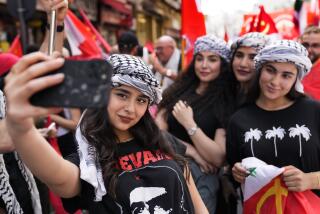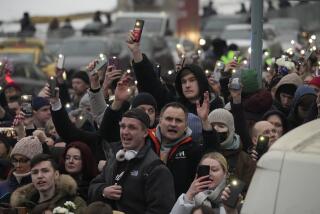Thousands Jeer Moscow Leaders : Soviet Union: May Day turns into a raucous protest. ‘Resign!’ is shouted as Gorbachev reviews the parade.
- Share via
MOSCOW — Thousands of Muscovites jeered President Mikhail S. Gorbachev and the Soviet leadership Tuesday as traditional May Day festivities on Red Square turned into a raucous sounding board for popular discontent and hostility to Communist rule.
“Socialism? No Thanks!” and “Down With the Empire of Red Fascism” declared two signs carried by marchers across the cobblestoned expanse under the Kremlin walls. It was an incredible public display of radicalism on a red-letter day on the Soviet calendar, a holiday honoring working-class solidarity worldwide.
Shaking their fists, Soviets by the thousands shouted “Shame, shame!” or “Resign!” at Gorbachev and the other Soviet leaders assembled atop Lenin’s mausoleum. Many of the dignitaries responded with stern expressions before turning their backs on the marchers and leaving the parade after only about 20 minutes.
Gorbachev’s policy of glasnost, or openness, notwithstanding, Soviet television cut off its transmissions from Red Square soon after the radicals began their march, though in past years it had broadcast May Day ceremonies in full.
Elsewhere in the country, tens of thousands of Ukrainians carrying icons marched in Lvov to demand independence for their republic, and Moldavians rallied in their capital, Kishinev, to wave their newly legalized flag, a red-yellow-blue banner identical to the flag of neighboring Romania.
A former Marxist-Leninist rite, worker parades for May Day were canceled in many cities. These included Leningrad, the site of the 1917 Russian Revolution where the City Hall is now controlled by radicals and progressives, and in the three Caucasus republics--Georgia, Armenia and Azerbaijan--where public gatherings have often sparked unrest or violence.
In the would-be independent Baltic state of Lithuania, however, residents reported that several thousand people, predominantly ethnic Russians, staged their own May Day demonstration, complete with red flags to reaffirm their attachment to the Soviet Union.
A similar demonstration occurred in Riga, the capital of neighboring Latvia, according to United Press International. About 15,000 mainly ethnic Russian workers opposed to Latvian independence marched amid a sea of red Soviet flags in a protest organized by Interfront, a Russian nationalist group that bitterly opposes Latvian secession from the Soviet Union, UPI reported.
In Moscow, the Red Square festivities, once a severely choreographed show of proletarian support for Kremlin policy, were opened this year for the first time to all wishing to take part. Assembled by the new Moscow city government--which is dominated by progressives--and unofficial organizations, tens of thousands of demonstrators trooped onto Red Square after an officially sanctioned rally organized by Soviet labor unions.
On the viewing stand atop the red marble building where Soviet founder V. I. Lenin’s body is preserved, Gorbachev and other members of the ruling Communist Party Politburo watched as the vast square filled with marchers carrying handmade posters and banners hostile to Communists or the emblems of rival political movements, including Social Democrats, Christian Democrats and the black flags of Russian anarchists.
Scores, perhaps hundreds, of marchers hoisted the red-yellow-green flags of Lithuania and signs demanding that the Soviet president lift his economic blockade of the republic that proclaimed its independence from Moscow in March.
“Today a Blockade of Lithuania, Tomorrow a Blockade of Moscow,” one protester’s placard predicted. Another’s, directly critical of Gorbachev, read: “The Blockade of Lithuania is the Shame of the President.”
Until this year, workers were compelled by their factory managements to attend the parade and even told which slogans to carry.
But on Tuesday, in a scene that seemed surreal for a May Day parade, a Russian Orthodox priest carried a giant crucifix fashioned from cardboard across Red Square. As he passed in front of the mausoleum, he halted, raised the crucifix and proclaimed in Gorbachev’s direction: “Christ has risen, Mikhail Sergeyevich!”
There was brutal criticism of Communists and the results of the policies they espouse. One banner called for imprisoning the “Kremlin Ceaucescus,” likening the Soviet leaders to the neo-Stalinist dictator of Romania, Nicolae Ceaucescu, and his wife, Elena, who were toppled and executed in December. Other signs called for Gorbachev and the entire Politburo to resign.
One marcher also carried a Soviet flag with the hammer and sickle cut out as a symbol of his repudiation of Soviet rule. Several banners lamented that the country where Lenin took power in November, 1917, had spent “72 Years on the Road to Nowhere.”
As they neared the mausoleum, a score of anarchists chanted “Down With the KGB!”--the Soviet secret police. But martial music that blared continuously from loudspeakers mounted on the battlements of the russet-brick Kremlin walls almost completely drowned out their cries, as it did of those marchers shouting, “Shame!”
As the radicals began to walk across the square, state-run television showed Gorbachev tapping his fingers on the parapet of the reviewing position, apparently irritated by the display. Politburo member Yegor K. Ligachev and Defense Minister Dmitri T. Yazov, two reputed conservatives, watched grim-faced.
The cries and whistles of derision from the protesters rose to a crescendo, with thousands joining in, as Gorbachev and the other members of the leadership turned their backs and vanished into the Kremlin.
For more than an hour afterward, the demonstrators continued their stop-and-go march. Red Square can hold up to 50,000 people, and the marchers seemed to fill it easily.
Their ranks were split into almost single-file processions by hundreds of KGB troops and police auxiliaries who stretched the length of the square from the State Historical Museum to the celebrated onion-domed St. Basil’s Cathedral. Behind the church and in other secluded spots such as the GUM department store, hundreds of Interior Ministry troops armed with Kalashnikov assault rifles were stationed in the event of trouble.
Even the sedate 40-minute rally organized by official Soviet trade unions that preceded the radical marchers’ arrival on Red Square showed the sweep of dissatisfaction with the meager economic results realized by Gorbachev’s reforms and widespread fears that workers and others will suffer as market-style policies are implemented.
“We’d stop being labor unions if we stopped defending the gains of the working class,” Gennady Yanayev, chairman of the sanctioned national trade union organization, told the rally as he stood on Lenin’s mausoleum. “We don’t have the right to leave veterans, single mothers or students to face the market alone.”
Other speakers and signs carried by union members opposed any economic measures that would increase unemployment or prices.
MAY DAY NOT THE SAME--Observances around the world reflect new democracies. A4
A MAY DAY SAMPLER Western Kremlinologists once scrutinized slogans used in May Day parades for clues to emerging Soviet government policies. The signs and banners carried by union workers and radicals across Moscow’s Red Square on Tuesday reflected both bread-and-butter concerns and political demands. Here are some examples: For Real Work, Real Pay Food Is No Luxury No to the Lowering of the Standard of Living We Want to Live, Not Just Exist Prices Under the Control of the Unions Socialism? No Thanks! The Blockade of Lithuania Is the Shame of the President Dictator Equals President Without Elections Down With the Empire of Red Fascism 72 Years on the Road to Nowhere
More to Read
Sign up for Essential California
The most important California stories and recommendations in your inbox every morning.
You may occasionally receive promotional content from the Los Angeles Times.













